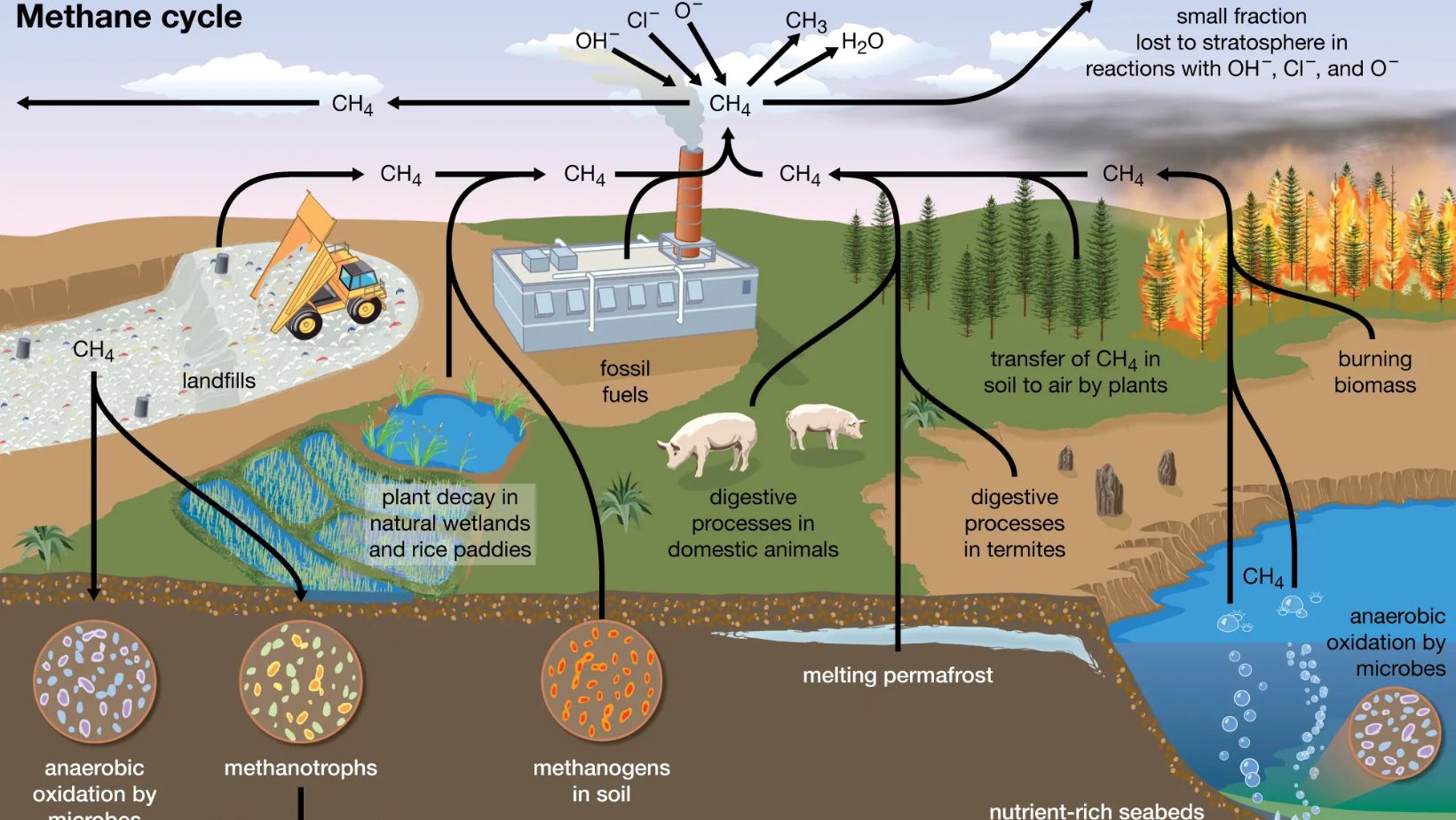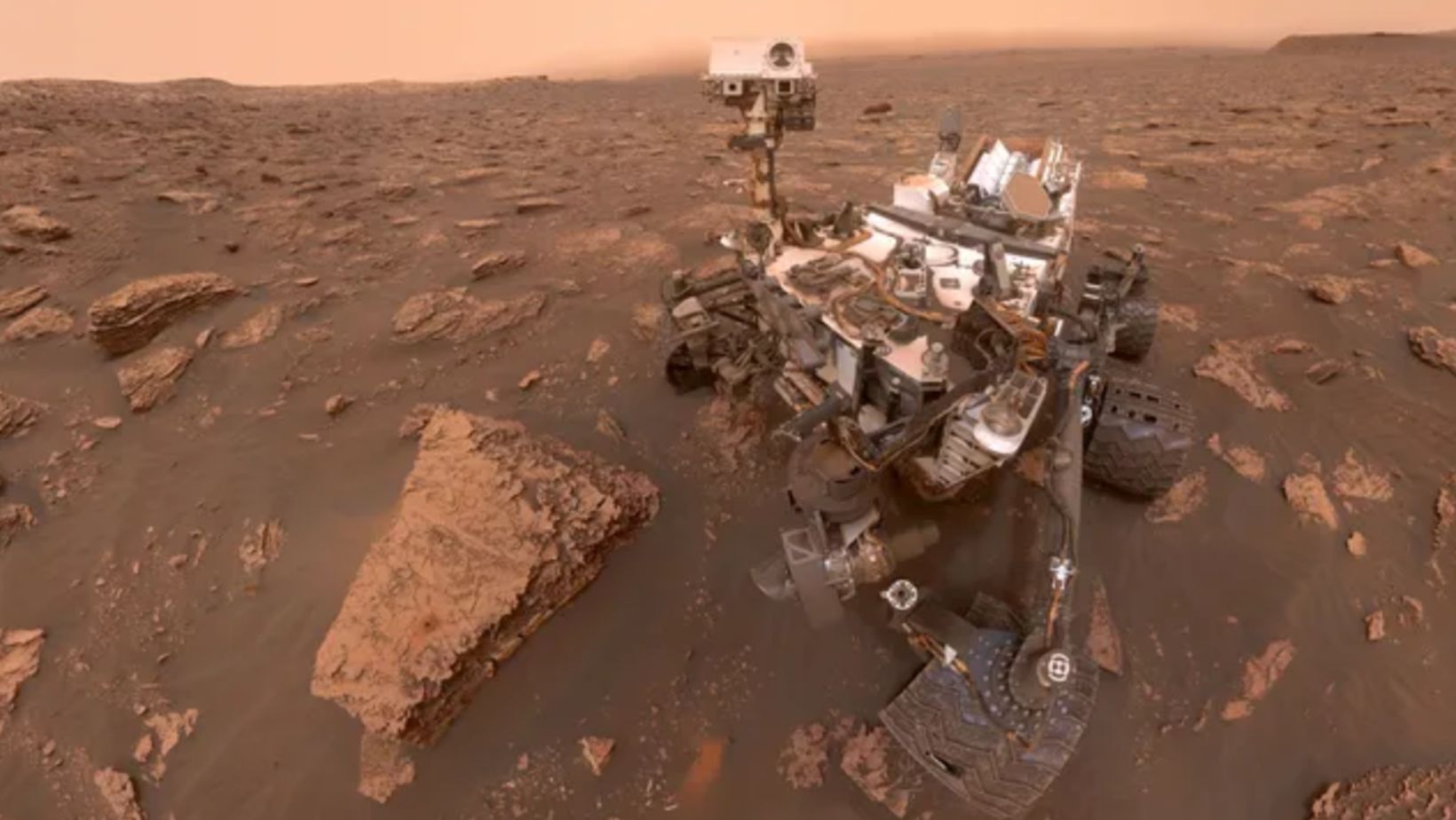In 2003, scientists made an exciting discovery: methane in the Martian atmosphere. This gas, often linked to life on Earth, raised eyebrows and fueled new questions about the Red Planet. Why would methane exist on Mars? Could it be a sign of past or even present life? Understanding methane is crucial for the search for life beyond Earth. It could point to microbial life forms or geologic activity beneath the surface. In this blog, we’ll explore why this discovery matters and what it means for humanity’s quest to unravel Mars’ secrets.
What Is Methane and Why Does It Matter?

Methane (CH₄) is a colorless, odorless gas composed of one carbon atom and four hydrogen atoms. It is the simplest hydrocarbon and is highly flammable. Methane is produced both naturally and through human activity, including the extraction of fossil fuels and agriculture. In the atmosphere, methane is a potent greenhouse gas, trapping heat and contributing to global warming.
Methane plays a significant role in biological processes on Earth. It is produced by microbes known as methanogens, which thrive in environments like swamps, landfills, and the digestive systems of animals such as cows. These microbes help break down organic material in the absence of oxygen, producing methane as a byproduct. In this way, methane is an essential component of the global carbon cycle.
Despite its role in natural processes, methane is a major concern for climate change. It has a much higher warming potential than carbon dioxide, even though it remains in the atmosphere for a shorter time. Reducing methane emissions is crucial for limiting global temperature rise and protecting the planet’s ecosystems.
The Discovery of Methane on Mars
Methane on Mars has been a subject of fascination for scientists. Its presence suggests potential biological or geological processes on the Red Planet. The discovery of methane was first reported by NASA’s Mars Express mission in 2003. This trace gas has been detected intermittently since, raising questions about its source.
In 2009, NASA’s Curiosity rover detected methane in the Gale Crater. The rover found seasonal variations in methane levels, further piquing interest. Later, in 2018, the ExoMars Trace Gas Orbiter detected methane levels at a global scale, confirming its presence but without identifying a clear source. These findings suggest that methane may be released from underground sources, possibly from microbial life or ancient geological activity.
Several instruments are used to detect methane on Mars. The Mars Express orbiter uses the PFS (Planetary Fourier Spectrometer) to measure atmospheric composition. Curiosity’s SAM (Sample Analysis at Mars) instrument also detects methane through gas chromatography. The ExoMars Trace Gas Orbiter uses a spectrometer called NOMAD, which helps detect methane at different altitudes, providing a more detailed global survey.
Potential Sources of Methane: A Planetary Puzzle
Methane is a potent greenhouse gas, and its origins are a mystery that spans both natural and potential biological processes. One of the primary natural sources of methane is volcanic activity. As magma rises, it releases methane trapped in the Earth’s crust. Additionally, water-rock reactions in certain environments, such as hydrothermal vents, can also produce methane when water interacts with minerals under high pressure.
Another possible source of methane is biological. Microbes, known as methanogens, thrive in oxygen-free environments, such as wetlands and the guts of animals, producing methane as a byproduct. These organisms may be present in extreme environments, like the icy moons of Jupiter and Saturn, raising the possibility of extraterrestrial methane production. Understanding methane’s origins is crucial for climate studies and searching for life beyond Earth.
Is Methane a Sign of Life?
Methane is often considered a potential sign of life because it is commonly associated with biological processes on Earth. On our planet, methane is produced by microorganisms known as methanogens, which thrive in environments like wetlands, the guts of animals, and deep-sea vents. These microorganisms break down organic matter, releasing methane as a byproduct. This connection between methane and living organisms makes it an intriguing molecule to search for on other planets, where its presence might indicate microbial life.
In addition to biological sources, methane can also be produced through geological processes, such as volcanic activity. However, methane from biological origins tends to have a distinct chemical signature that can help scientists identify life-related production. On Earth, methanogens play a vital role in the carbon cycle, helping to maintain environmental balance. Studying methane’s presence on other planets, like Mars, could therefore provide crucial clues about the possibility of life beyond Earth.
The Role of Mars’ Subsurface in the Methane Mystery

Mars has long fascinated scientists due to its potential to harbor life. One of the key mysteries is the presence of methane in its atmosphere. Despite the planet’s cold, arid surface, methane is still detected, and this has led to various theories. One hypothesis is that Mars’ subsurface could play a role in methane release, as the surface conditions alone are too harsh for methane to survive long.
The planet’s thin atmosphere and extreme cold make it unlikely that methane is produced on the surface. However, beneath the Martian crust, conditions may be different. The subsurface could harbor microbial life that produces methane as a byproduct, similar to how microbes on Earth produce methane. Additionally, geological processes like the interaction of water with minerals could also release methane from underground sources.
The idea of subsurface microbial life remains speculative, but it’s supported by observations of seasonal methane spikes. If microbial life does exist beneath Mars’ surface, it would provide critical evidence for life beyond Earth. This theory continues to fuel the search for more data on Mars’ subsurface composition and potential biosignatures.
The Seasonal Variations of Martian Methane
Methane on Mars has been a subject of great interest due to its seasonal fluctuations. Observations from various missions, such as NASA’s Curiosity rover, have detected changes in methane levels over different times of the year. These variations seem to correlate with Mars’ seasons, rising during warmer periods and dropping in colder seasons. Scientists have found that these fluctuations occur primarily in the planet’s northern hemisphere.
These seasonal changes in methane could suggest active processes occurring below the surface of Mars. One possibility is that methane is being released from underground sources, such as geothermal activity or microbial life. The connection between methane levels and temperature hints that these processes may be linked to Martian weather patterns. While the exact cause of these fluctuations is still unclear, they remain a significant clue in the search for signs of life on Mars.
Recent Research: What Have Mars Missions Uncovered?
Mars missions, particularly NASA’s Curiosity rover and the ExoMars mission, have provided groundbreaking insights into the Red Planet. Curiosity, which landed on Mars in 2012, discovered evidence of ancient water flows and the presence of organic compounds. These findings suggest that Mars may have supported microbial life in its distant past. The rover’s analysis of soil samples also revealed important information about the planet’s atmosphere and its ability to sustain life.
The ExoMars mission, a joint effort between ESA and Roscosmos, aims to search for signs of past life. Its rover, Rosalind Franklin, will explore the Martian surface for potential biomarkers. Recent data from both missions has shown that Mars had conditions that could have been conducive to life. This strengthens the theory that microbial organisms might have once existed on Mars.
Ongoing research continues to refine our understanding of Mars’ geological and atmospheric history. New data from these missions helps scientists map the planet’s climate and determine its potential for future human exploration. As the missions progress, more discoveries about Mars’ past and its ability to support life are expected to emerge, offering us a clearer picture of this mysterious planet.
Challenges in Proving Life on Mars
Proving life on Mars is a daunting task. One key challenge is confirming whether methane, a gas found in the Martian atmosphere, has biological origins. Methane is often associated with life, as many Earth-based organisms produce it. However, on Mars, there are several uncertainties surrounding its source.
The complexity lies in the fact that methane can also be produced by non-biological processes, such as volcanic activity or chemical reactions between water and rocks. These processes make it difficult to definitively link methane to living organisms. Scientists must also account for the fluctuating levels of methane on Mars, which could suggest seasonal changes rather than a steady biological source.
Another issue is the limited data available. The tools used by Mars rovers and orbiters can detect methane but can’t always pinpoint its exact origin. This leaves room for alternative explanations, such as chemical processes or ancient microbial activity that has since ceased. Until more evidence is gathered, proving life on Mars remains a significant challenge.
The Future of the Mars Methane Mystery

The mystery of methane on Mars continues to puzzle scientists. Recent detections of methane in the Martian atmosphere have raised questions about its origin. Some believe it could be linked to microbial life, while others suggest geological processes could be responsible. Upcoming missions and new technologies may provide crucial answers.
NASA’s Perseverance rover and ESA’s ExoMars mission are key to studying methane on Mars. These missions will collect samples from the surface and analyze the atmosphere. New technology, such as advanced spectrometers, will help detect trace gases more accurately. This will allow for deeper insights into the methane fluctuations observed on Mars.
The potential for discovering life on Mars is high if methane is found to have a biological origin. If microbes are responsible for methane, it could indicate a habitable environment beneath the surface. Understanding methane will also help assess Mars’ past habitability and its potential for future human exploration.
As missions continue, the data gathered may reveal whether Mars ever supported life. With advancing technology, scientists are closer than ever to solving the Mars methane mystery.
Conclusion: Mars Methane Mystery: Does It Point to Life Below the Surface?
In conclusion, the discovery of methane on Mars plays a crucial role in the search for life beyond Earth. Methane is a potential indicator of biological or geological processes, making it a key focus for scientists studying the planet’s past and present conditions. This finding opens new avenues for future Mars exploration, suggesting the possibility of microbial life or active geological processes beneath the surface. As missions to Mars continue, methane will guide scientists in prioritizing areas for exploration and help refine our understanding of the planet’s potential to support life. The quest for life on Mars is now more promising than ever.
FAQs About Mars Methane Mystery: Does It Point to Life Below the Surface?
What is methane, and why is its presence on Mars significant?
Methane is a simple gas that, on Earth, is often associated with biological processes. Its presence on Mars raises questions because it could indicate either ongoing biological activity or geological processes, potentially suggesting life beneath the Martian surface.
How was methane detected on Mars?
Methane was first detected on Mars by the Mars Express orbiter in 2003 and later confirmed by NASA’s Curiosity rover. The detection methods include atmospheric analysis, spectrometric readings, and measuring fluctuations in methane levels over time.
Can methane on Mars be explained by geological processes?
Yes, methane can also be produced by geological processes, such as the interaction of water with minerals deep below the Martian surface. However, the exact cause of methane on Mars remains uncertain, and scientists are studying both biological and non-biological sources.
Does the methane on Mars support the theory of past or present life?
While methane could theoretically result from microbial life, it is not definitive evidence of life. Some researchers believe that subsurface microbial life could still exist, while others point to geological processes as the more likely cause of the methane.
What are the next steps in investigating Mars’ methane mystery?
Future missions, including advanced rovers and orbiters, will continue to monitor methane levels and attempt to pinpoint the source. Instruments designed to measure gases more precisely and perform deeper analyses of Martian soil and rocks are expected to provide more insights into whether life might be contributing to the methane signature.

